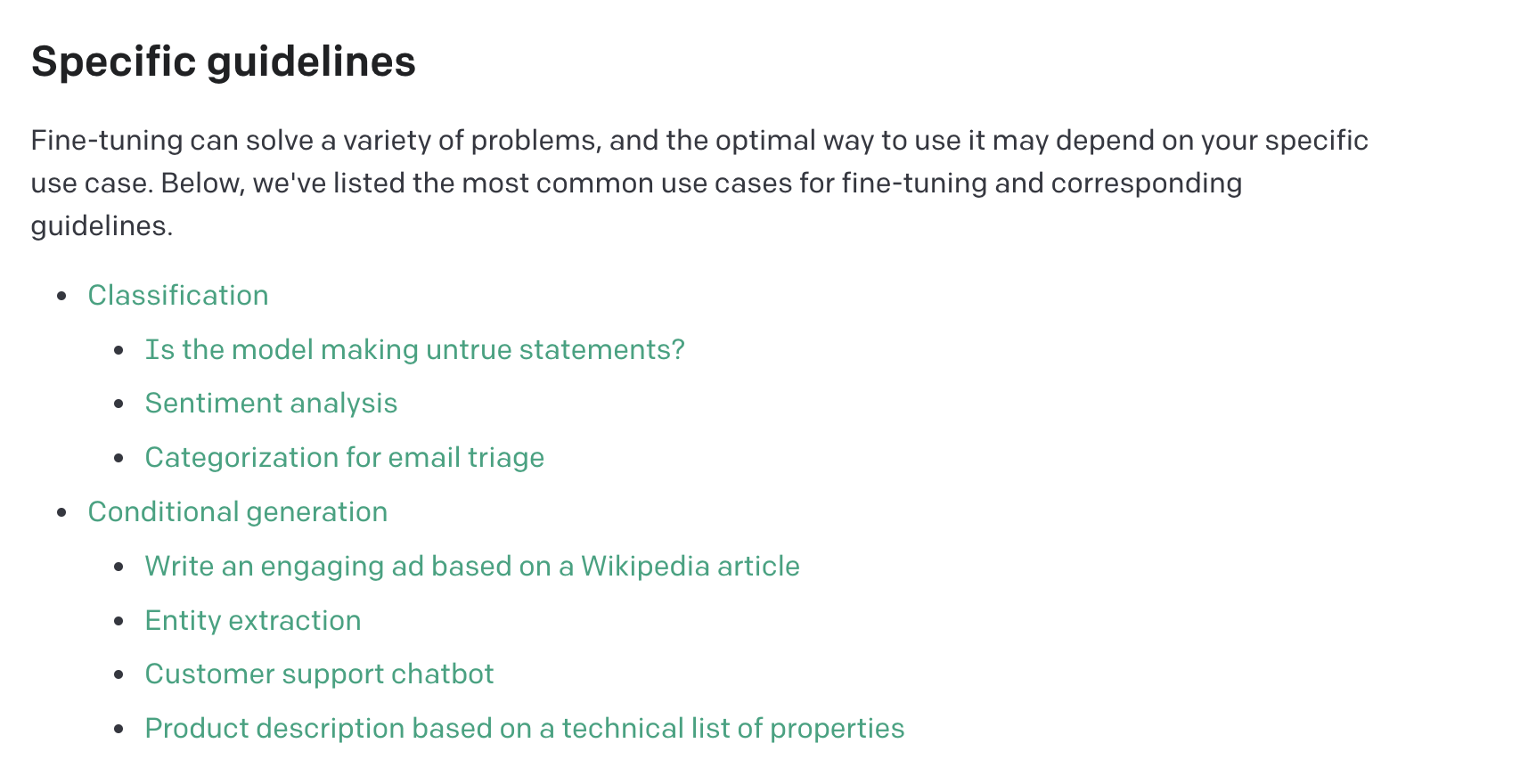GPT護理機器人
引子
書接上文《GPT接入企微應用 - 讓工作快樂起來》,我把GPT接入了企微應用,不少同事都開始嘗試起來了。有的淺嘗輒止,有的刨根問底,五花八門,無所不有。這裡摘抄幾份:
「幫我寫一份表白信,我們是大學同學,暗戀十年」
」順產後多久可以用收腹帶?生完寶寶用收腹帶好還是不用好「 (背景:公司主營月子中心,護理相關的領域知識是公司對於護士培訓的重點內容)
」我的工資是多少「 (這個有點強機器人所難了,不過如果機器人有了公司的人事語料資料,應該是可以回答的)
......
總的來說,除了一些嚐鮮,獵奇之外,有相當一部分還是諮詢公司的內部的相關資訊,比如HR方面的育兒假等,再就是母嬰護理方面的問題了(公司有近60%的是護理人員,日常工作就是與寶寶,寶媽一起,這就不奇怪了)。
看到這些問題後,我就開始嘗試通過Fine-tune訓練公司內部的護理機器人,希望他可以為護士們的工作帶來一些便利。諸多嘗試失敗後,索性就放了一些時間。
恰逢五一假,回了媳婦孃家,掐指一算,已經3年6個月沒有回來過了,二娃子都快3歲了,還沒見過外婆。想不到娃子親舅舅,我到清閒了,又撿起護理機器人搗鼓起來了。於是有了這篇文章。
Fine-tune可能真的不合適
剛看到Fine-tune的介紹時就想,如果通過fine-tune構建個性化的模型,匯入公司的母嬰護理知識,並且在未來了問答中進化,變成企業內部專家。所以一開始就是向這樣的路子摸索著。畢竟介紹裡也說了通過少量樣本即可完成訓練,分類這樣的任務可能只需要200個左右的樣本即可。(其實問答模型的樣本要求至少要有幾千個可能會有點效果)

當然,檔案中也有一些關於Fine-tune的一些指南和準則。一來是全是英文檔案,理解不太深入;二來就是無知無畏,不嘗試下就是不死心。這是檔案原文,大概的意思Fine-tune可以用來解決一些類似分類(判斷對錯,情緒判斷(樂觀,悲觀),郵件分類),以及擴寫總結之類的場景。 檔案也有提到案例」Customer support chatbot「,這可能也是大家這樣嘗試的原因之一吧。 在其demo推薦使用 emebedding 來實現,也是本文的重點內容。這是後
 雖然通過Fine-tune的方式最終也沒有好的效果,一來可能是樣本太少,或者樣本質量不好;也或者過程中有疏漏的地方。在這裡也和大家一起探討下。畢竟fine-tune的方式還是讓人非常神往的。實現程式碼基本是參考了 openai-cookbook 中的 fine-tuned_qa Demo。大致流程如入:
雖然通過Fine-tune的方式最終也沒有好的效果,一來可能是樣本太少,或者樣本質量不好;也或者過程中有疏漏的地方。在這裡也和大家一起探討下。畢竟fine-tune的方式還是讓人非常神往的。實現程式碼基本是參考了 openai-cookbook 中的 fine-tuned_qa Demo。大致流程如入:
- 環境設定就不多說了(版本 python 3.10.4 整個過程基本還是流暢的。除了v-p-n自身原因折騰好久(原來用的是mono),換個使用者端居然好了)
- 收集文字資料並根據token的限制,合理分段落。(我自己則是找到內部了母嬰護理培訓的電子版本。)
- 用模型text-davinci-003 為每個段落自動生成若干問題,並根據段落及問題自動生成答案。
- 使用所有生成問題及答案組織成fine-tuen所需要的資料集。
- 建立新模型並使用。
1,文字分段 - 因為拿到的資料是word,並且有標題,就直接根據標題他分段了,超過2048的再分一次,程式碼如下(現學現用,比較粗漏)
import docx
import pandas as pd
def getText(fileName):
doc = docx.Document(fileName)
TextList = []
data = {"title":"","content":""}
for paragraph in doc.paragraphs:
if paragraph.style.name == 'Heading 1':
print("title %s " % paragraph.text)
if (len(data['content']) > 0):
datax = {}
datax['title'] = data['title']
datax['content'] = data['content']
TextList.append(datax)
data['title'] = paragraph.text
data['content'] = ''
else:
data['content'] += paragraph.text+"\n"
TextList.append(data)
return TextList
## 根據doc 轉 csv
if __name__ == '__main__':
fileName = '/Users/jijunjian/openai/test2.docx'
articList = getText(fileName)
count = 0
for article in articList:
if len(article['content']) > 800:
print("%s,%s,\n%s" % (article['title'], len(article['content']),article['content']))
count += 1
header = ['title', 'content']
print("總共 %s 篇文章" % count)
pd.DataFrame(articList, columns=header).to_csv('data_oring.csv', index=False, encoding='utf-8')
2,生成問題與答案 - 這樣生成的質量可能不是太高,可能實際使用時還是要對生成的問題和答案,讓領域專家進行修正比較好。
據官方檔案介紹,建議生成的資料集中,prompt與completion都要有固定的結尾,且儘量保證其他地方不會出現這個,所以我們這裡使用了」\n\n###\n\n「作為結束標誌。
1 import pandas as pd 2 import openai 3 import sys 4 sys.path.append("..") 5 from tools.OpenaiInit import openai_config 6 from transformers import GPT2TokenizerFast 7 8 9 tokenizer = GPT2TokenizerFast.from_pretrained("gpt2") 10 11 def count_tokens(text: str) -> int: 12 """count the number of tokens in a string""" 13 return len(tokenizer.encode(text)) 14 15 16 COMPLETION_MODEL = "text-davinci-003" 17 FILE_TUNE_FILE = "search_data.jsonl" 18 19 20 # 獲取訓練資料 21 def get_training_data(): 22 file_name = "data_oring.csv" 23 df = pd.read_csv(file_name) 24 df['context'] = df.title + "\n\n" + df.content 25 print(f"{len(df)} rows in the data.") 26 return df 27 28 29 # 根據內容,生成問題 30 def get_questions(context): 31 print("正在生成問題") 32 try: 33 response = openai.Completion.create( 34 engine=COMPLETION_MODEL, 35 prompt=f"基於下面的文字生成問題\n\n文字: {context}\n\n問題集:\n1.", 36 temperature=0, 37 max_tokens=500, 38 top_p=1, 39 frequency_penalty=0, 40 presence_penalty=0, 41 stop=["\n\n"] 42 ) 43 return response['choices'][0]['text'] 44 except Exception as e: 45 print("建立問題錯誤 %s" % e) 46 return "" 47 48 49 # 根據問題,生成答案 50 def get_answers(row): 51 print("正在生成答案") 52 try: 53 response = openai.Completion.create( 54 engine=COMPLETION_MODEL, 55 prompt=f"基於下面的文字生成答案\n\n文字: {row.context}\n\n問題集:\n{row.questions}\n\n答案集:\n1.", 56 temperature=0, 57 max_tokens=500, 58 top_p=1, 59 frequency_penalty=0, 60 presence_penalty=0 61 ) 62 return response['choices'][0]['text'] 63 except Exception as e: 64 print (e) 65 return "" 66 67 68 # 獲取訓練資料 /Users/jijunjian/tuningdata.xlsx 69 if __name__ == '__main__': 70 openai_config() 71 df = get_training_data() 72 df['tokens'] = df.context.apply(count_tokens) 73 # questions 根據返回生成 74 df['questions']= df.context.apply(get_questions) 75 df['questions'] = "1." + df.questions 76 77 df['answers']= df.apply(get_answers, axis=1) 78 df['answers'] = "1." + df.answers 79 df = df.dropna().reset_index().drop('index',axis=1) 80 81 print("正在儲存資料") 82 df.to_csv('nursing_qa.csv', index=False) 83 84 85 86 df['prompt'] = df.context + "\n\n###\n\n" 87 df['completion'] = " yes\n\n###\n\n" 88 89 df[['prompt', 'completion']].to_json(FILE_TUNE_FILE, orient='records', lines=True) 90 91 search_file = openai.File.create( 92 file=open(FILE_TUNE_FILE), 93 purpose='fine-tune' 94 ) 95 qa_search_fileid = search_file['id'] 96 print("上傳檔案成功,檔案ID為:%s" % qa_search_fileid) 97 98 # file_id = file-Bv5gP2lAmxLL9rRtdaQXixHF
3,根據生成資料集,建立新的模型。
官方的demo,還有生成驗證集,測試集,生成相識的文字,同樣的問題與答案來增加一些對抗性,因為最終效果不太好,再是檔案中有使用search 模組,但是這已經下線了,我用prompt-completion的資料結構模擬了下,也不知道有沒有效果, 因為使用openai tools 建立模型可以有一些互動動作,也方便看一些執行結果,花費資料,這裡就使用這這工具作了演示,執行一段時間後,可以通過」openai.Model.list()「檢視我們建立的模型。當時大概有1000來個問題與答案,花費了0.78刀。(這是4月13嘗試的,因為效果不好,結果一放就是半月有餘了。時間真是如白駒過隙一般)
1 openai api fine_tunes.create -t "discriminator_train.jsonl" -v "discriminator_test.jsonl" --batch_size 16 --compute_classification_metrics --classification_positive_class yes --model ada --suffix 'discriminator' 2 3 Uploaded file from discriminator_train.jsonl: file-5OeHx3bMDqk****** 4 Uploaded file from discriminator_test.jsonl: file-AnOiDwG1Oqv3Jh****** 5 Created fine-tune: ft-cQBMLPzqVNml1ZWqkGYQKUdO 6 Streaming events until fine-tuning is complete... 7 8 (Ctrl-C will interrupt the stream, but not cancel the fine-tune) 9 [2023-04-13 23:17:05] Created fine-tune: ft-cQBMLPz******** 10 [2023-04-13 23:17:22] Fine-tune costs $0.78 11 [2023-04-13 23:17:23] Fine-tune enqueued. Queue number: 3
最後,效果不太理想,一番嘗試後,看到檔案中的提示資訊:
」Note: To answer questions based on text documents, we recommend the procedure in Question Answering using Embeddings. Some of the code below may rely on deprecated API endpoints.「 於是藉著五一的空閒,開始嘗試emebedding 方式 了
emebedding可能是當下最好的選擇
GPT擅長回答訓練資料中存在的問題,對於一些不常見的話題,或者企業內部的語料資訊,則可以通過把相關資訊放在上下文中,傳給GPT,根據上下問進行回答。因為不同模型對於token的限制,以及Token本身的成本因素。
具體實現時,我們需要把文字資訊Chunk(分塊)並Embed(不知道如何翻譯)得到一個值,收到問題時,同樣進行Embed,找到最相近的Chunk,做為上下文傳給GPT。官方檔案如下:
Specifically, this notebook demonstrates the following procedure:
- Prepare search data (once)
- Collect: We'll download a few hundred Wikipedia articles about the 2022 Olympics
- Chunk: Documents are split into short, mostly self-contained sections to be embedded
- Embed: Each section is embedded with the OpenAI API
- Store: Embeddings are saved (for large datasets, use a vector database)
- Search (once per query)
- Given a user question, generate an embedding for the query from the OpenAI API
- Using the embeddings, rank the text sections by relevance to the query
- Ask (once per query)
- Insert the question and the most relevant sections into a message to GPT
- Return GPT's answer
一開始本想參考這個demo Question_answering_using_embeddings.ipynb 編寫程式碼,後來有意無意看到使用llama_index的實現,並且對於語料資訊格式無要求,就摘抄過來了,感謝程式碼的貢獻者,節省了大家好些時間。
#!/usr/bin/env python
# coding=utf-8
from langchain import OpenAI
from llama_index import SimpleDirectoryReader, LangchainEmbedding, GPTListIndex,GPTSimpleVectorIndex, PromptHelper
from llama_index import LLMPredictor, ServiceContext
import gradio as gr
import sys
import os
os.environ["OPENAI_API_KEY"] = 'sk-fHstI********************'
#MODEL_NAME = "text-davinci-003"
MODEL_NAME = "ada:ft-primecare:*************"
def construct_index(directory_path):
max_input_size = 2048
num_outputs = 512
max_chunk_overlap = 20
chunk_size_limit = 600
prompt_helper = PromptHelper(max_input_size, num_outputs, max_chunk_overlap, chunk_size_limit=chunk_size_limit)
llm_predictor = LLMPredictor(llm=OpenAI(temperature=0.7, model_name=MODEL_NAME, max_tokens=num_outputs))
documents = SimpleDirectoryReader(directory_path).load_data()
#index = GPTSimpleVectorIndex(documents, llm_predictor=llm_predictor, prompt_helper=prompt_helper)
service_context = ServiceContext.from_defaults(llm_predictor=llm_predictor, prompt_helper=prompt_helper)
index = GPTSimpleVectorIndex.from_documents(documents, service_context=service_context)
index.save_to_disk('index.json')
return index
def chatbot(input_text):
index = GPTSimpleVectorIndex.load_from_disk('data/index.json')
response = index.query(input_text, response_mode="compact")
return response.response
if __name__ == '__main__':
iface = gr.Interface(fn=chatbot,inputs=gr.inputs.Textbox(lines=7, label="輸入你的問題"),outputs="text",title="護理智慧機器人")
## 用於生成資料, 放在docs資料夾下
##index = construct_index("docs")
iface.launch(share=True, server_name='0.0.0.0', server_port=8012)
使用了gradio 作為演示,效果如下,基本可以根據我們的內部培訓資料中回覆,美中不足的就是通過要10幾秒才可以完成回覆,至少比之前fine-tune有了很大的進步了。至此,總算可以安撫下這半月的苦惱了。(下圖中的output 如果變成自定義的文字,嘗試多次一起沒有成功,也是有點遺憾)

曲折的部署之路
孟子有云:獨樂樂不如眾樂樂。如何讓同事們一起體驗,又是一個艱鉅任務開始了。再則也需要讓護理專家們看看回復的質量,以及如何優化文字內容。原本以為部署是一件簡答的事兒,但是對於python菜-雞的我,每一步都是坎坷。
一開始以為直接用pyinstaller 打包就可以直接放在伺服器上執行,結果 pyinstaller -F, -D 嘗試很久都無法打包依賴, --hidden-import 也用了, .spec也用了,都不好使。索性放棄了。
到了晚上12點半時,毫無進展,索性直接放原在碼放上去。結果又提示無法安裝指定版本的langchain。然後開始搗騰pip版本升級到最新,python版本升級到3.10.4(和本地一樣)。
python升級後,又是提示ModuleNotFoundError: No module named '_bz2',總算是錯誤資訊變了。這個錯誤大概就是原來自帶中的版本中有_bz2模組,重安裝的3.10中沒有,解決版本都是複製這個檔案到新的版本中。
mv _bz2.cpython-36m-x86_64-linux-gnu.so /usr/local/python/lib/python3.10/lib-dynload/_bz2.cpython-310-x86_64-linux-gnu.so
再次執行終於啟動了,太不容易了。設定好防火牆,騰訊雲的安全組, 輸入外網ip:8012,瀟灑的一回車 - 還是無法存取。 借用毛爺爺的一句話描述下當下的心情:它是站在海岸遙望海中已經看得見桅杆尖頭了的一隻航船,它是立於高山之巔遠看東方已見光芒四射噴薄欲出的一輪朝日,它是躁動於母腹中的快要成熟了的一個嬰兒。加之夜確實太深了,才踏實的睡下了。
1 /usr/local/python/lib/python3.10/site-packages/gradio/inputs.py:27: UserWarning: Usage of gradio.inputs is deprecated, and will not be supported in the future, please import your component from gradio.components 2 warnings.warn( 3 /usr/local/python/lib/python3.10/site-packages/gradio/deprecation.py:40: UserWarning: `optional` parameter is deprecated, and it has no effect 4 warnings.warn(value) 5 /usr/local/python/lib/python3.10/site-packages/gradio/deprecation.py:40: UserWarning: `numeric` parameter is deprecated, and it has no effect 6 warnings.warn(value) 7 Running on local URL: http://127.0.0.1:8012 8 Running on public URL: https://11d5*****.gradio.live
第二天,找到gradio 中Interface.launch 的引數有個 server_name 設定成 通過設定server_name=‘0.0.0.0’ 即可通過IP存取。 通過ss -tnlp | grep ":8012" 也可以看到埠的監聽從 」127.0.0.1:8012「 就成了 」0.0.0.0:8012 「。
LISTEN 0 128 0.0.0.0:8012 0.0.0.0:* users:(("python",pid=2801254,fd=7))
展望一下
從目前測試的情況來,每問一個問題成本在10美分左右(成本還是比較高),優化的方向可能Chunk的大小,太小無法包含住夠的上下問,太大成本又比較高。再回頭看Fine-tune的方式,應該是前期訓練話費的成本會比較高,後期回答的成本會比較少,只是目前訓練效果不太好,看其他文章也是同樣的問題。從目前的情況來可能 emebedding的是一個較為合適的落地方式。
接下看看使用的情況,如果效果不錯,考慮增加語音轉文字,用GPT回覆答案,甚至可以再文字轉語音播報出來,這樣護士們的工作可能會更加便利與快樂了。
成為一名優秀的程式設計師!

